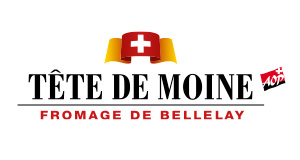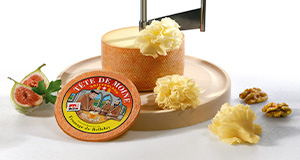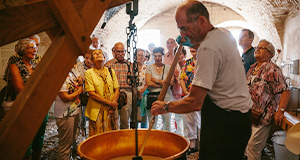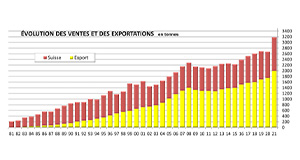Tête de Moine AOP, Bellelay cheese is a first-class product crafted in small cheese dairies according to traditional methods which have to comply with the requirements of the AOP specifications. Milk producers, cheese-makers and affineurs use modern procedures, but they work according to traditional and more time-consuming methods than those used for industrial cheese production.
During the green feeding period the dairy cows are supposed to graze on the meadows. In winter they are primarily fed on hay. Since the milk produced should be as natural as possible the use of animal meal and hormones, genetically modified organisms or products of that kind is strictly prohibited.
The milk is collected and processed within the AOP region, just a few kilometres away from the cheese dairies, and is supplied to the cheese dairies at least once a day. To preserve its quality, the milk is processed as soon as possible, 24 hours after milking at the latest. The village dairies process the milk according to traditional procedures the requirements of which are set down in the AOP specifications and guarantee absolutely fresh raw material.
First the milk has to be tested, then it is poured into a copper vat and where evening and morning milk supplies are mixed. Selected cheese cultures are added, which will produced desired milk acidity. This processed is called maturation. Rennet (a natural product), is then added, which curdles the milk in about 30 minutes.
The jelly-like curd is cut with a cheese harp to form grains and to separate the whey. The cheese mass is heated to 46-53°C which removes the water from the cheese grains.
The cheese mass is now filtered or pumped off and pressed into moulds to form small cylinder-shaped Tête de Moine AOP wheels. The moulds are about twice the size of the cheese since the curd still contains a lot of water. The cheese is pressed and turned until the whey has been drained off. Then a casein mark, showing at least the accreditation number of the dairy and the production date, is affixed onto each cheese so that they may be traced back to their origin.
The cheese wheels from the previous day are immersed in a brine bath for at least 12 hours. By absorbing salt they expel more water, the rind starts forming and the maturing period begins.
The young cheeses are put onto spruce boards and aged for at least 75 days in a humid cheese cellar (about 90% humidity) at a temperature of about 13-14°C within the geographical AOP region. During that time they have to be cared for and turned regularly. The cheeses are brushed with a mixture of saline and bacteria culture so that they form a smear on their rind, a process that promotes maturing from the exterior to the interior of the cheese. No colours or chemical surface treating agents are allowed.
Quality testing of Tête de Moine AOP is done in compliance with AOP specifications. A so-called assessment is performed every month in the cellars of the cheese dairies. The experts assess the cheese quality as to the appearance, holes, body (colour, ability to be curled), aroma and taste.
Cheese which does not meet the required quality standards cannot be sold as Tête de Moine AOP.












